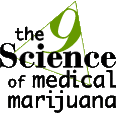This website
sponsored by:
![]() New, Emerging Evidence of Marijuana's Medical Efficacy
New, Emerging Evidence of Marijuana's Medical Efficacy
Cannabinoids and anandamide
In the last few years, research has revealed that a class of chemicals found in marijuana that includes delta-9-THC, called cannabinoids, is very similar to a naturally occurring chemical in the body called anandamide. Numerous nerve receptors throughout the brain and body are triggered by the presence of anandamide. These particular nerve sites are involved in pain control, memory and cognition, motor functioning, nausea and vomiting, and internal eye pressure. The discovery of these receptor sites and of the chemical similarities between cannabinoids and anandamide has provoked some new interest in research on the medicinal properties of marijuana. In fact, in February of 1997, a National Institutes on Health panel highlighted the discovery of cannabinoid receptors as key to further exploring marijuana's therapeutic potentials.
Nonaddictive pain control
In October 1997, new animal studies of cannabinoids by research groups at the University of California in San Francisco, the University of Michigan, and Brown University were presented at the annual meeting of the Society for Neuroscience. Researchers in these studies found evidence that THC and other cannabinoids have a direct effect on pain signals in the central nervous system, by tracing the biochemical pathway that pain signals follow from the site of an injury, through the spinal cord, to the brain. The studies also concluded that, unlike the current crop of painkillers based on opiates, cannabinoids are not addictive, nor do they appear to carry the risk that patients may develop tolerance for them and require increasing doses to achieve
relief.
Protecting the brain from effects of stroke, other disorders
More recently, in just the last few months, new information has emerged from studies by federal researchers at the National Institutes of Mental Health. Their reports have stated that THC, the chief psychoactive compound found in marijuana, and cannabidiol (CBD), a nonpsychoactive component, both appear to protect brain cells from the damage that often occurs during a stroke. When the brain's blood supply is cut, as occurs during a stroke, THC and CBD act as powerful antioxidants, protecting the brain cells from exposure to toxic levels of the brain chemical called glutamate. This finding also indicates that marijuana may hold medical value in the treatment of brain injuries and diseases such as Alzheimer's and Parkinson's.

